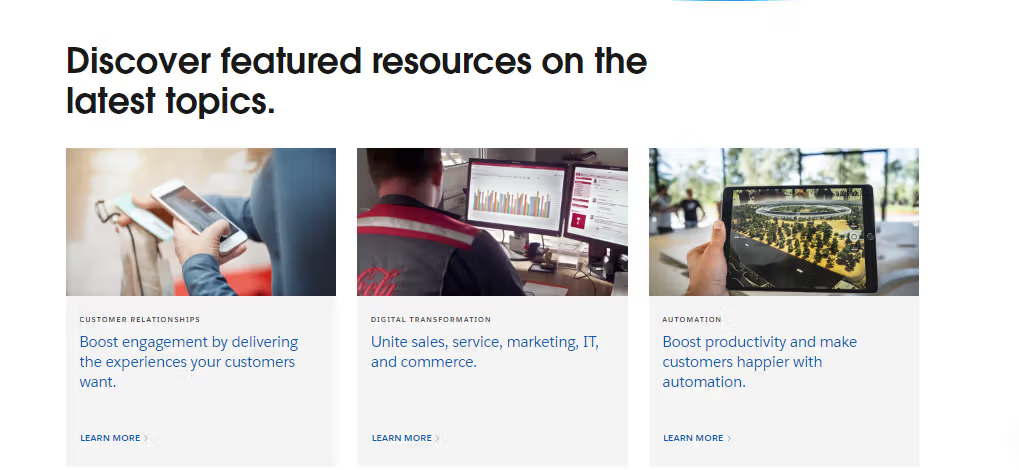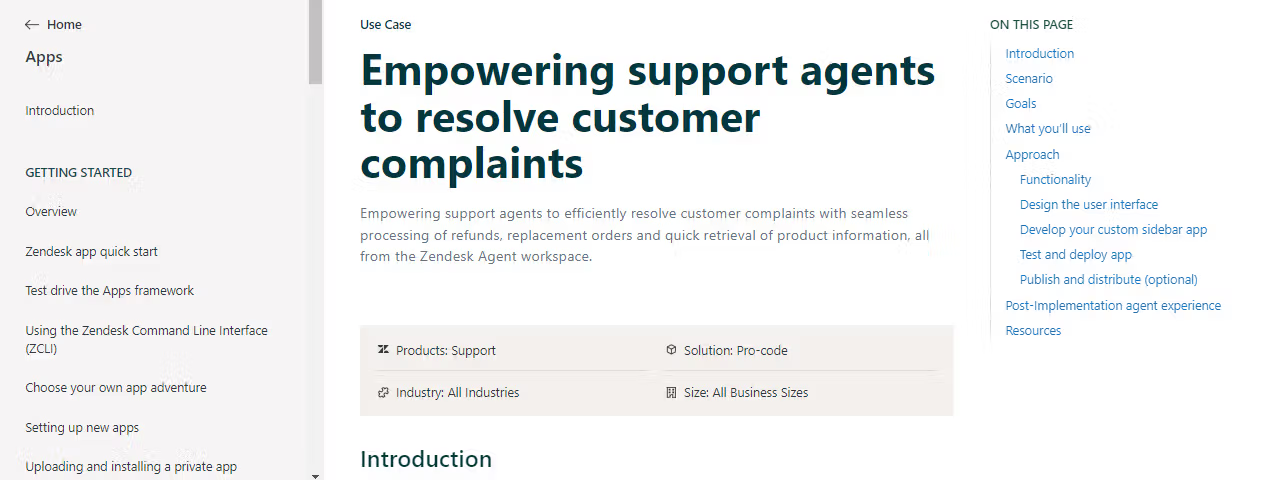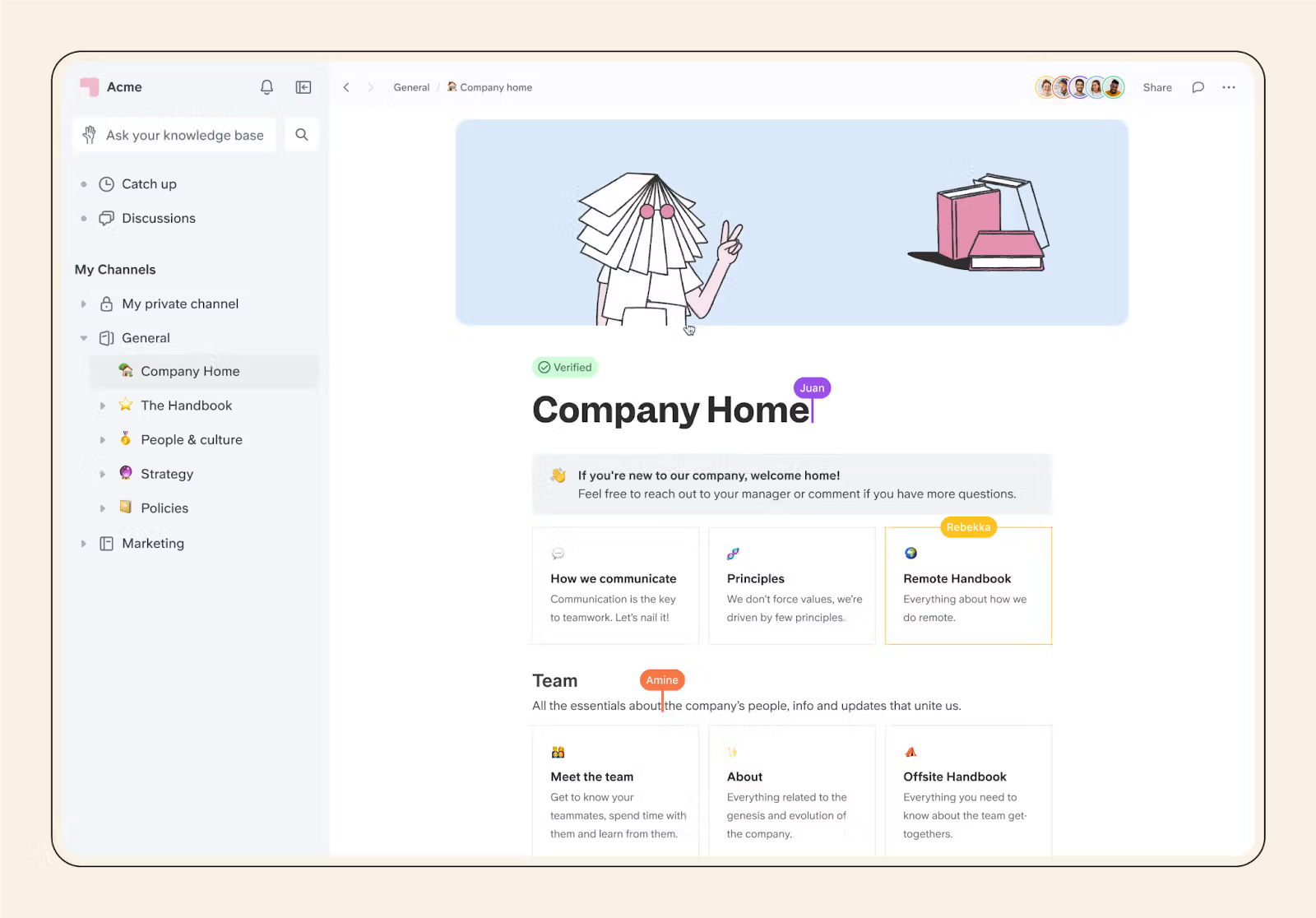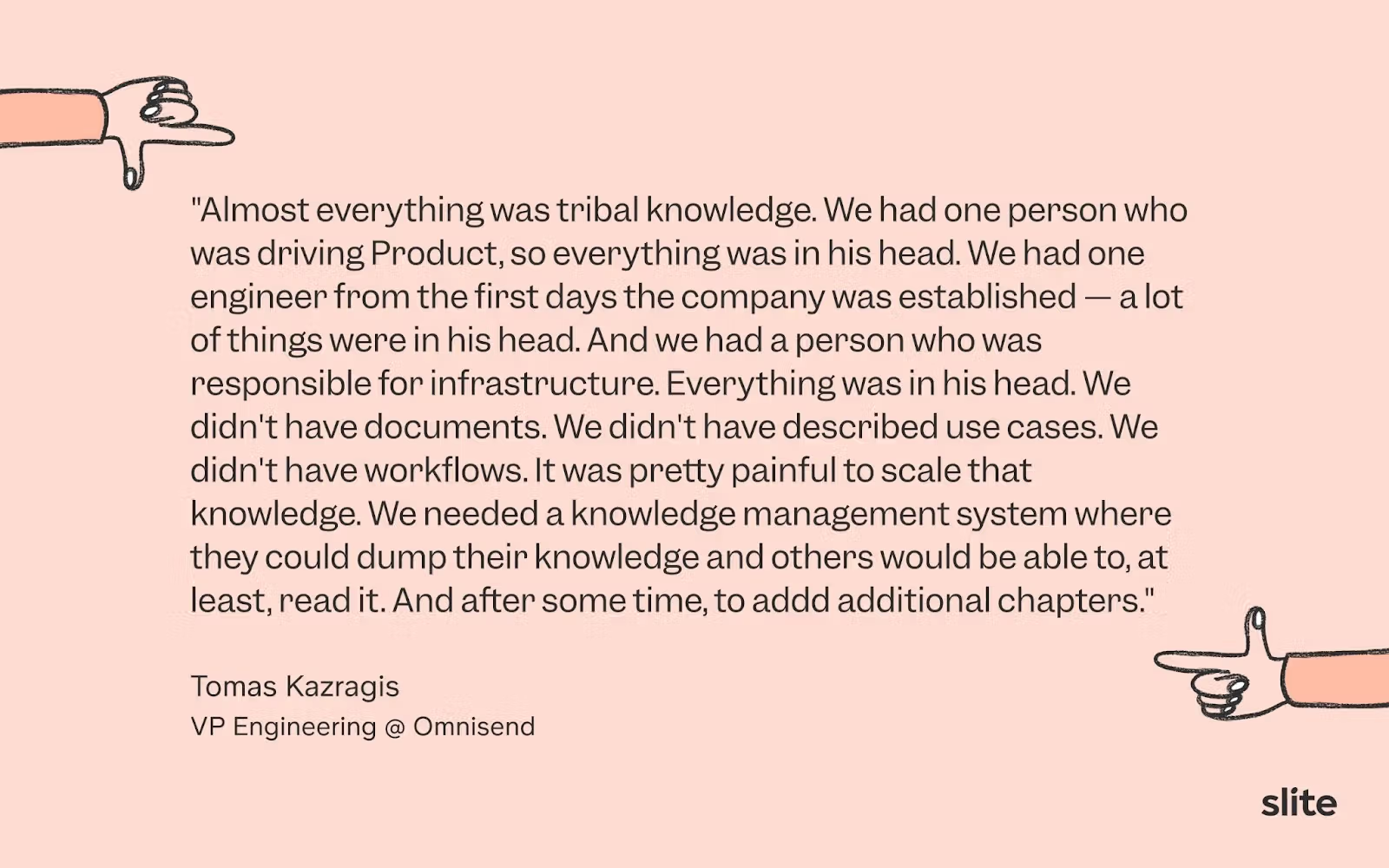Your product team has finally released the beta version of the product they have been working on for months.
Everyone is excited.
The product team sets up a company-wide meeting to show the product to everyone.
And they did it too. Customer success, marketing, sales—everyone digs deep into the product with the product head. But…
After the meeting is over, everything brushes off.
“What was the X feature that was mentioned on the call?”
“We can't access the tool, so how will our writers write blog posts and user manuals on the same?”
Urgh. Lots of chaos for each function.
You need to understand how to organize and manage knowledge correctly.
And how to do it?
This article walks you through different types of knowledge and how you can implement them in your life and work.

Types of knowledge
Knowledge is mainly divided into four main types:
- Tacit
- Explicit
- Procedural
- Declarative
- Empirical
- A Priori
- A Posteriori
Domain knowledge, which is specialized expertise in a particular field, distinguishes itself from general knowledge.
However, you’ll get to know a few other supporting knowledge types (such as empirical, a priori and a posteriori).
Tacit knowledge
Tacit knowledge is intangible and intuitive knowledge that relies on observation, practice, personal experiences, and social interactions. Think: insights, intuition and skills rather than verbal or written instructions.
However, tacit knowledge is difficult to share and articulate. Why so? Because the information consumed in this process is thought-based.
Characteristics of tacit knowledge
- Difficult to articulate
- Personal experiences
- Intuitive and informal
- Mentorship and job shadowing
Let's explain it better to you with a few examples.
In life:
- Your intuition when someone is lying to you or when a friend is in trouble.
- Your intuitiveness when driving the car and you're about to change lanes without signalling.
In a professional setting:
- A salesperson gauges a client’s mood and adjusts their pitch accordingly.
- A writer’s understanding of engaging introductions and conclusions.
- A technician’s ability to diagnose the issue in appliances.
- A chef’s knowledge of flavours and cooking techniques to adjust the recipe.
Practical application in action
Let’s see how tacit knowledge is being implemented in real life.
Problem-solving
Let's say a team member experiences friction in their workflow with their current project management tool. So, they look for another solution based on their experience and needs.
Crisis management
In a high-pressure situation, leaders:
- gauge the situation
- look at past experiences
- understand how the situation was handled
- This helps them make the decision accordingly.
Team building
When leaders understand their team members’ strengths and weaknesses, they better know the team dynamics. Result? They can build a cohesive, high-performing team.
How do we transfer tacit knowledge?
- Ask specific questions to extract the information via surveys and polls
- Use community forums and user groups to collect experiences and information
- Document the knowledge directly using knowledge management tools
Pro tip: Use Slite's collaborative features like comments and mentions to share your tacit knowledge on a specific document or wiki shared with other team members.
Explicit Knowledge
Explicit knowledge is structured and easily transferable information—mostly formal and documented in the form of books, courses, PDFs, whitepapers, and so on.
Characteristics of explicit knowledge
- Accessible
- Formal and structured
- Reproducible
Explicit knowledge examples include FAQs, instructions, and data reports, which illustrate the types of information that can be easily documented and shared within an organization.
For example, Salesforce packages its knowledge into easily accessible resources like detailed documentation, user manuals, and best practices guides.

Want to see more examples in action? Here you go.
In life:
- User manuals for home appliances to operate and troubleshoot the device.
- Cookbooks with detailed recipes, cooking techniques, and ingredients for each recipe.
- Skincare tutorials on Instagram and YouTube by lifestyle influencers sharing their skincare routine and review of skincare products.
In professional setting:
- Employee handbook documenting the company’s policies, procedures, expectations, and culture.
- Product demo created by the sales team to educate customers on the product features.
- Training manuals to educate employees about specific processes and the company’s products.
Practical applications in action!
Let’s see how explicit knowledge is being put into action in real life.
Employee onboarding
Giving handbooks and training manuals to new hires helps them extract information about company policies, processes, culture, and product information. This packaged information (explicit knowledge) helps new hires perform better. In fact, Angela, our People Ops Champion, considers it a must-have document. Get onboarding template here.
Standard operating procedures (SOPs)
Companies introduce SOPs to help employees perform routine tasks. This way, they can:
- Ensure consistency
- Maintain quality
- Reduce errors and misunderstandings at work
- Improve employee onboarding
Knowledge repository
Store all the relevant internal documents, FAQs, and how-to guides in one place—with your knowledge repository.
This is perfect because your employees can:
- Access the knowledge repository and solve their problems
- Customer support can use it to resolve customer issues quickly
- Troubleshoot a specific problem for customers without having to reach out to customer support
But how do we transfer explicit knowledge?
- Conduct regular meetings within teams to distribute information.
- Leverage external resources like webinars and online courses.
- Conduct structured training sessions.
Pro tip: Capture and organize explicit knowledge in easily searchable documents and wikis.
Procedural Knowledge
Procedural knowledge is the action-oriented knowledge that helps you understand the specific tasks to be performed. You can gain this knowledge through hands-on experience and continuous practice. It helps accomplish tasks that require precision and efficiency.
This type of knowledge usually emphasizes ‘how’ to accomplish a specific task vs. declarative knowledge, which focuses on the ‘what’ of the task.
Characteristics of procedural knowledge
- Action-oriented
- Gained through practice
- Sequential and logical
'Know how' refers to the practical application of knowledge and skills acquired through experience, highlighting its importance in problem-solving and execution within both personal and organizational settings.
For example, Zendesk has developed step-by-step guides for customer agents to handle different types of inquiries.

Here are a few more examples of procedural knowledge.
In life:
- Learning how to drive the car
- Using a chef’s cooking technique to prepare a dish
In professional setting:
- An employee using project management tools to create tasks, set deadlines, assign tasks to team members, and track progress.
- A customer service agent follows a specific process to handle customer objections.
Practical applications in action
Let’s see how procedural knowledge is being put into action in real life.
Employee training and development
“How do I use Salesforce to identify patterns in sales conversations and close deals?” This could be your next SDR, too. Yikes.
With procedural knowledge, you can train your employees on the specific tasks or tools to use regularly in their workflows. It’s a win-win situation. It helps you remove friction from your employees’ workflow so that they perform their jobs consistently.
Operational efficiency
Team members will likely make errors when they don't get clear instructions on accomplishing a task. Think of SDRs qualifying unqualified leads. They need a step-by-step process to understand what goes into qualifying a prospect to sell to sales-qualified leads.
Troubleshooting
What if either of the two things happen:
- A customer reaches out to your support team to resolve an issue they experienced with the product.
- Your employees experience bugs in their work devices.
In both cases, you need procedural knowledge to understand the problem and identify and resolve it.
But how do we share procedural knowledge?
- Pair less experienced employees or new hires with experienced employees for hands-on training and guidance.
- Use shadowing techniques to help new hires learn from experienced employees.
- Capture lessons learned, best practices and case studies in the knowledge base.
Pro tip: Document procedural knowledge with Slite’s step-by-step guides and checklists.

Declarative knowledge
Declarative knowledge is the conceptual knowledge you need to understand the ‘know-what’ of the specific topic and break down the complex information into simpler ones.
Read: definitions and facts.
Declarative knowledge is further divided into two types of knowledge: episodic and semantic.
- Episodic knowledge. It focuses on recollecting specific events and experiences, such as time, places, and emotions. This type of memory is best for learning about certain behaviors using past experiences.
- Semantic knowledge. It focuses on factual and conceptual knowledge that breaks down concepts, definitions, and information. This type of memory doesn’t give you contextual details about the piece of information as episodic memory does. Still, it can be best used to understand complex information well.
Propositional knowledge refers to specific facts or propositions that can be articulated and verified. It represents clear information about events or concepts and plays a crucial role in educational systems and cognitive processes.
Declarative knowledge can be used as standalone knowledge if your goal is to explain a complex concept. But it complements well with procedural knowledge.
While declarative knowledge answers the ‘what’ of the complex concept, procedural knowledge breaks it down further by emphasizing ‘how it is done’.
Characteristics of declarative knowledge
- Factual
- Easily communicated
- Foundational
Need a few examples for better understanding? Here you go.
In life:
- Recalling your first day at the office
- Recognizing traffic signals and their indication
- Knowing the nutritional information of common foods
In education:
- Understanding the mathematical formulas
- Studying the timeline of major events in US history
- Familiarity with specific terms and jargon within a specific field
Practical applications in action
Let’s see how procedural knowledge is being put into action in real life.
Training and onboarding
When a new SDR joins the organization, they have no idea of the company's policies, the process from hiring to finally onboarding, and the specifications of the product they'll be selling.
To avoid this clueless situation for the SDRs (and other employees), companies include an employee onboarding guide that provides the employees with video tutorials, detailed documentation, and guidance on the company’s policies, processes, culture, and products.
Curriculum development
Have you ever wondered how educators plan what topics the students will learn throughout the academic year? It's a well-thought process:
- What topics should be taught to students in the academic year?
- Which ones would be omitted?
- Which topics or subjects can be considered as additional?
- Which ones will be considered optional?
Answering the ‘what’ and ‘which’ to these questions makes it easy for educators to systemize the entire curriculum plan.
Performance metrics analysis
Think: a sales manager is training the new SDRs on the team and reviewing each SDR’s performance after training them. Next up, they'll look for performance metrics like:
- Number of sales calls booked
- Duration of each call
- Lead to opportunity conversion rate
- Revenue generated per rep
By analyzing the numbers, the sales manager can identify the top-performing reps and those needing more training.
That's precisely what declarative knowledge helps you do—be it any form of performance analysis in business.
Decision making
When you get into the numbers game—and analyze data—you understand what’s working and what’s not.
Say the marketing team analyzed their recent influencer campaign. The budget spent vs. the leads generated via the influencers was quite shabby.
Because they studied the campaign analysis, they now know that the campaign with specific influencers didn't work out in their favour, and they need to optimize the campaign.
In short, analyzing the campaign is declarative knowledge the marketing team obtained for making informed decisions.
How do we share declarative knowledge?
- Leverage online courses to deliver factual knowledge
- Use infographics and charts to simplify the concepts
Pro tip: Store and share declarative knowledge in structured knowledge bases and team handbooks.
Other types of knowledge
Besides the knowledge we just learned, there are three more types of knowledge.
They’re not standalone knowledge types but provide a support system to the primary knowledge types. Empirical knowledge, for instance, is derived from sensory experiences and observations. Scientific knowledge, on the other hand, is a form of empirical knowledge that is validated through evidence, emphasizing its importance in justifying claims based on observations.
Empirical knowledge
You can gain this knowledge through sensory experience, observation, and experimentation, usually part of scientific research.
For example, behavioral studies in psychology and user testing in product development.
Empirical knowledge mostly aligns with tacit and procedural knowledge. Why? Because this knowledge is gained through observation, practice and real-world application. For instance, a technician learns repair techniques through hands-on experience and observation.
A Priori knowledge
This type of knowledge is gained through reasoning and logic and is associated with foundational principles. For example, multiplying 6 and 6 gives you 12 (and not 10).
A Priori knowledge aligns with declarative knowledge as it explains theoretical concepts without direct observation.
A Posteriori Knowledge
This type of knowledge is gained through experience, observation and empirical evidence. Although a posteriori knowledge seems similar to empirical knowledge, a posteriori knowledge is based on sensory experiences.
A Posteriori knowledge aligns with explicit knowledge as it involves facts learned through experiences and observation—which can be documented.
But how do these different types of knowledge work together?
These different types of knowledge work together in doublets or triplets. Understanding various types of knowledge is foundational for developing effective knowledge management processes. What does that even mean? Well, let’s understand it better.
Explicit knowledge and tacit knowledge form a duo that is essential for any organization. A well-crafted knowledge management strategy is crucial in effectively capturing and managing these various types of knowledge.
The duo: explicit and tacit knowledge
When you combine tacit and explicit knowledge together, you can easily document your personal experiences and difficult-to-articulate insights into:
- video training
- ebooks
- bite-sized social media content.
But imagine if you didn't have the tacit knowledge on the specific topic. Could you structure this knowledge into explicit knowledge? You can't.
An excellent example of this duo knowledge type is Omnisend.
Two people solely had the information about their product: one engineer and one product person. And the rest of the team? They had no clarity on the product features and how it works.

That's where Omnisend started packaging the information into documentation, video clips from presentations, webinars and meetings.
Let’s break it down:
- Tacit knowledge: Knowledge the product person and the engineer have at Omnisend.
- Explicit knowledge: Knowledge packaged into documentation, presentations, webinars and meetings.
Also read: How Omnisend stays aligned through rapid growth
The trio: explicit, tacit, and procedural knowledge
Explicit and tacit knowledge are the supporting anchors for procedural knowledge.
Meaning?
Procedural knowledge is gained through practice and experience, which equals tacit knowledge. However, explicit knowledge uses tacit knowledge to package the information into guidelines and documentation.
Once this is done, procedural knowledge uses this documentation and guidelines to execute actionable outcomes.
Let's understand with an example:
Alex, an experienced Operations Manager, always recognizes when the inventory levels are insufficient based on market trends and customer demand.
He wants to educate his team members about his approach to make the process more efficient. So, he packages his knowledge into explicit knowledge.
Here's how he does this:
- He created a detailed manual outlining the steps for monitoring inventory levels.
- He created SOPs to conduct regular inventory audits, set reorder points, and manage stock levels using historical data and market trends.
- He created training modules to teach new employees how to interpret sales data and apply this knowledge to inventory management.
With this explicit knowledge, Alex helped his team with the following:
- Develop a step-by-step process to regularly check inventory levels
- Document the steps for reordering the stock
- Establish a foolproof process to handle unexpected inventory shortage
This way, Alex enabled tacit, explicit and procedural knowledge for his team.
The trio: declarative, procedural and explicit
Declarative and explicit knowledge are the anchors for procedural knowledge. What does that mean?
When you want to simplify a concept, you'll use declarative knowledge to explain what the concept is. It is then followed by explicit knowledge that explains the concept in detail.
Once you have knowledge in place, you can combine it with procedural knowledge, where you'll focus on the step-by-step action and how it will be performed practically.
For instance, when a sales rep gives a demo to a customer, first, they'll talk about their product and its features—what exactly they do.
After this, the rep gives more details about the product, such as how it benefits the customer, the specific use case, and how the existing customers have been leveraging it.
Once the rep emphasizes all the information, they’ll give a step-by-step walkthrough of how the customer can use the product in their workflow.
And voila!
Let's break it down:
- Declarative knowledge: Sales rep telling the customer what the product does and what their product features are.
- Explicit knowledge: Sharing more details like customer’s pain points, product benefits, and use case.
- Procedural knowledge: Step-by-step walkthrough of each product feature.
Putting it all together with Super
The real knowledge challenge lies in accessing this scattered information when you need it most. Your team's knowledge doesn't just live in a single knowledge base—it's spread across Slack conversations, Google Drive documents, project management tools, customer support tickets, and countless other platforms.
This creates a common scenario: your sales team needs context about a client's technical requirements (stored in Linear), recent conversations about their account (in Slack), and previous proposal templates (in Google Drive). Traditionally, this means switching between multiple tools and hoping to piece together the complete picture.
This is where modern AI-powered search platforms like Super (built by the same team behind Slite) transform how teams access organizational knowledge. Instead of hunting through different systems, teams can ask natural language questions like "What's the latest update on Project Alpha?" and get comprehensive answers that pull together explicit documentation, procedural guidelines, and contextual information from across all connected tools.

Super understands the relationships between different types of knowledge, connecting the procedural steps documented in your wiki with the tacit insights shared in team discussions and the explicit data stored in your project management tools. It provides source citations with confidence scores, so you always know where information comes from and how reliable it is.
For organizations serious about knowledge management, having a system that can intelligently connect all types of knowledge across your entire tech stack isn't just convenient—it's essential for maintaining competitive advantage. Book a demo to see how enterprise AI search can transform your organization's knowledge access.

